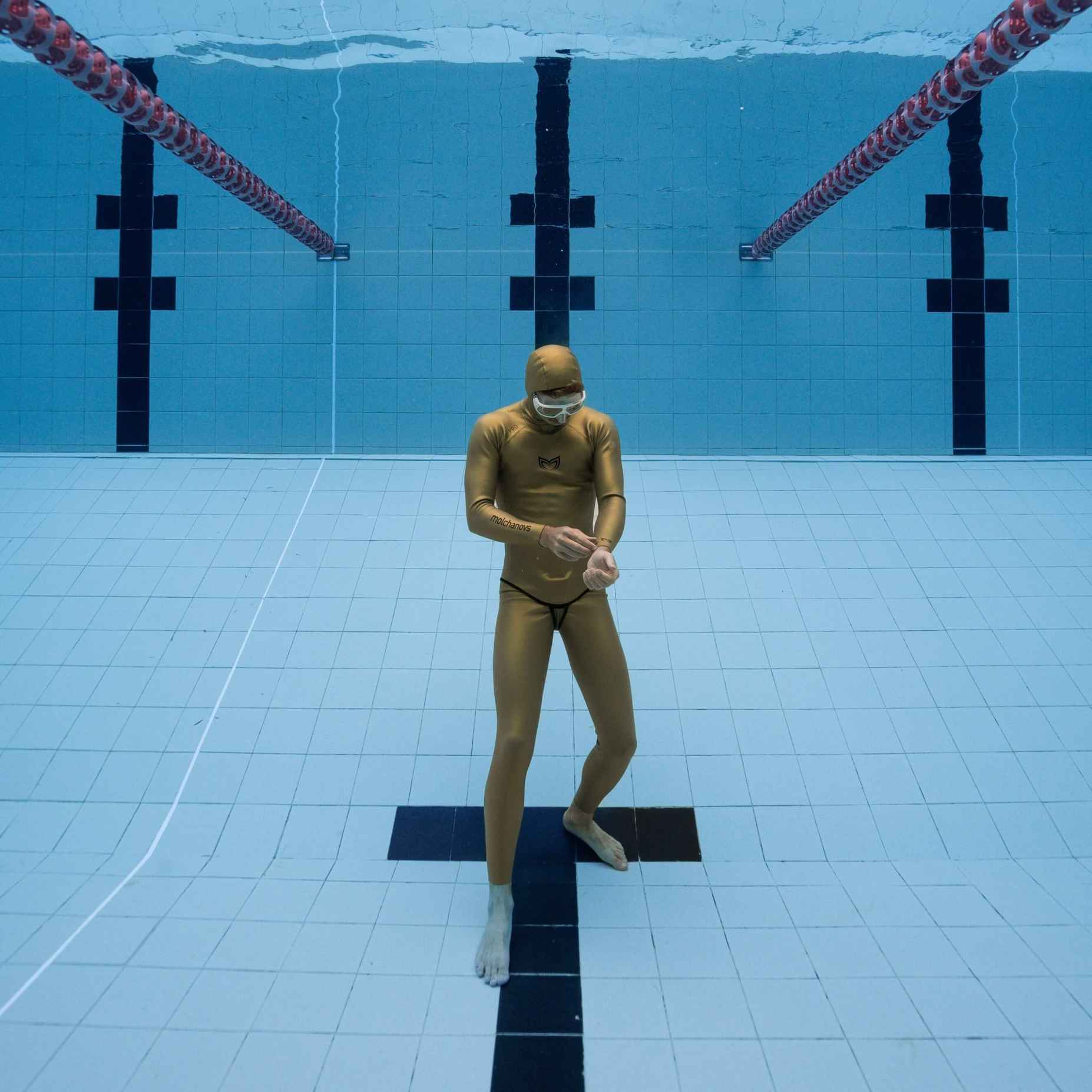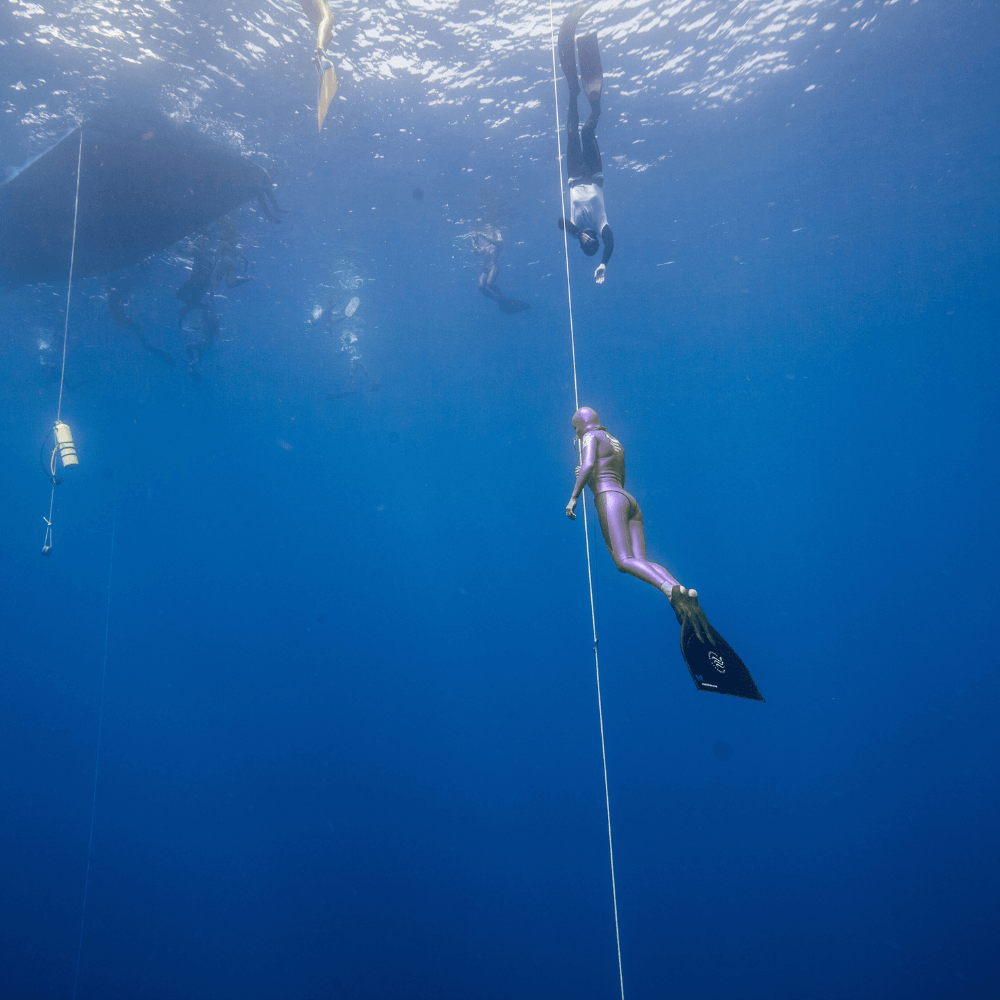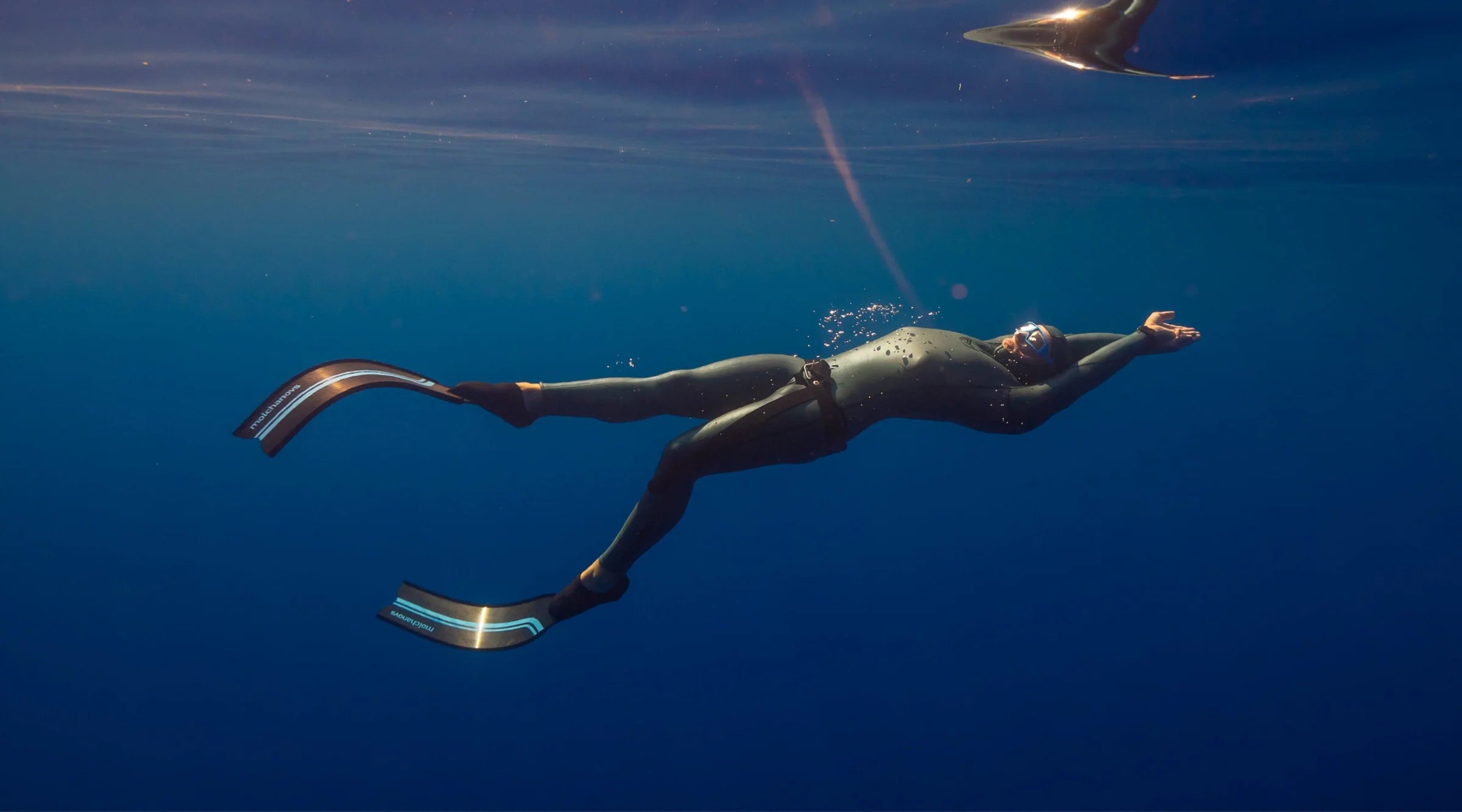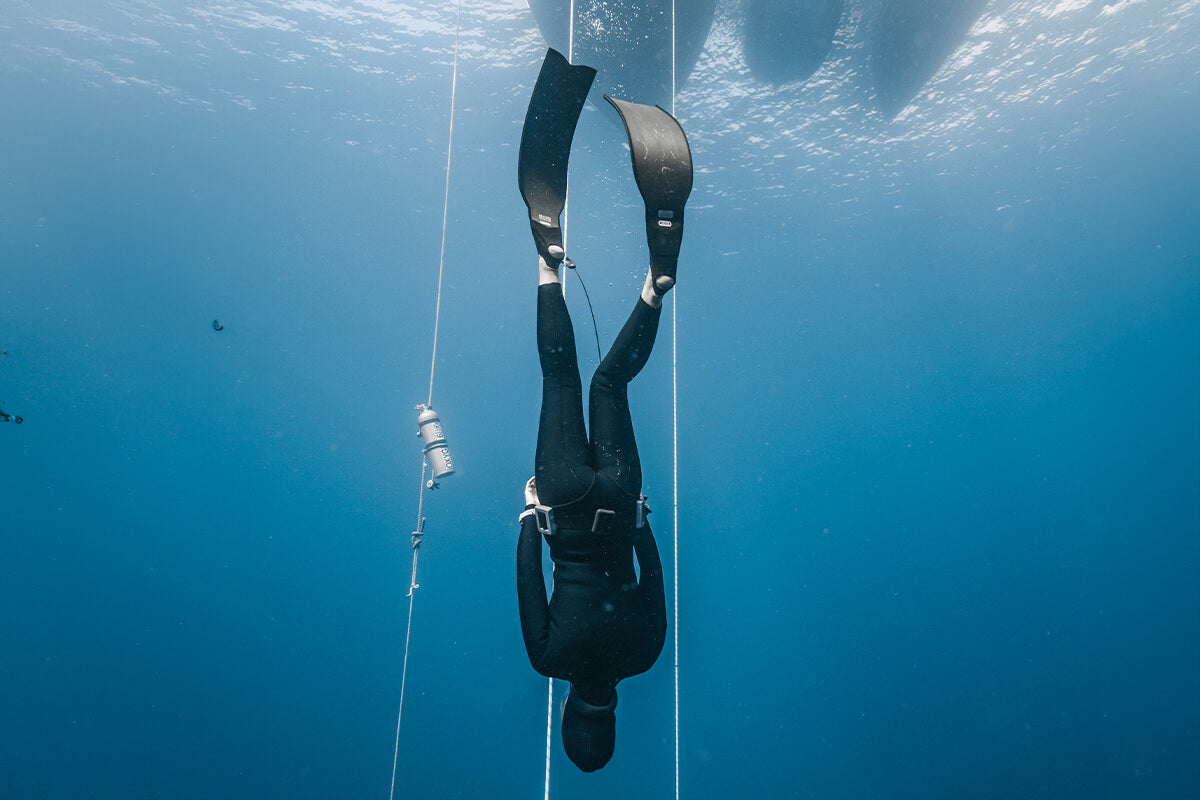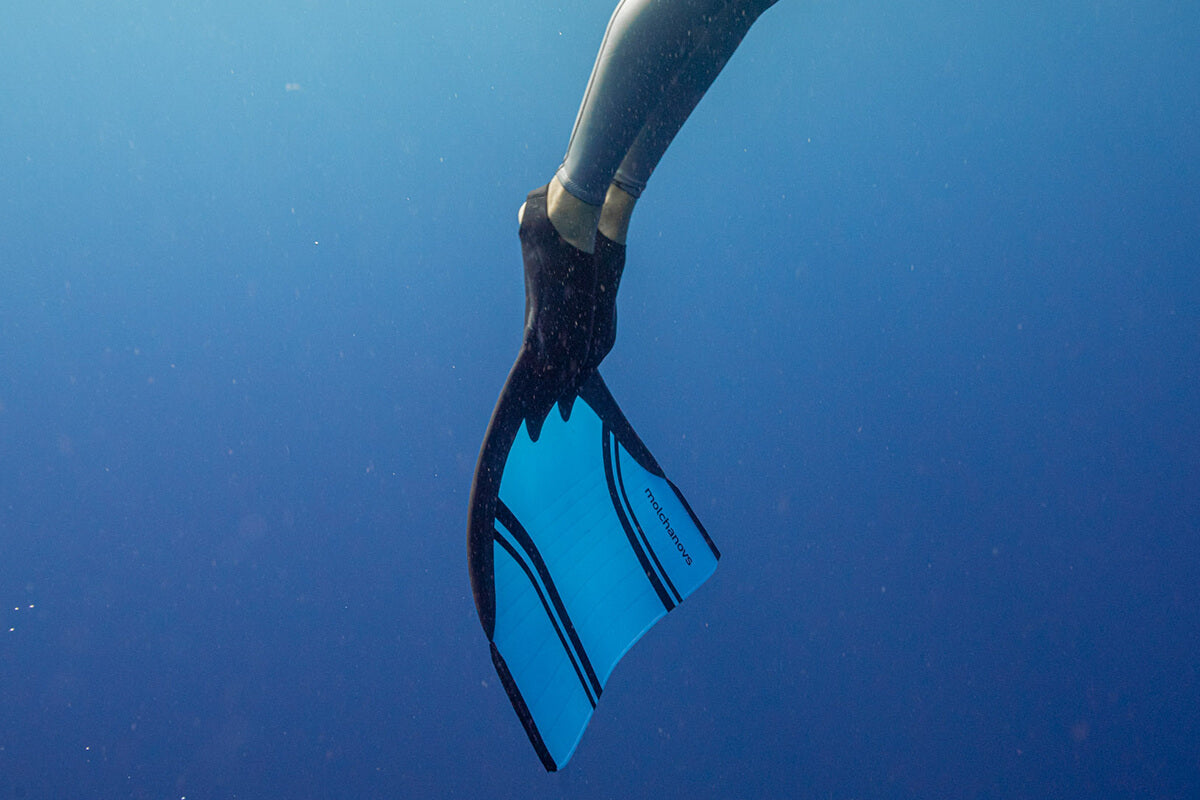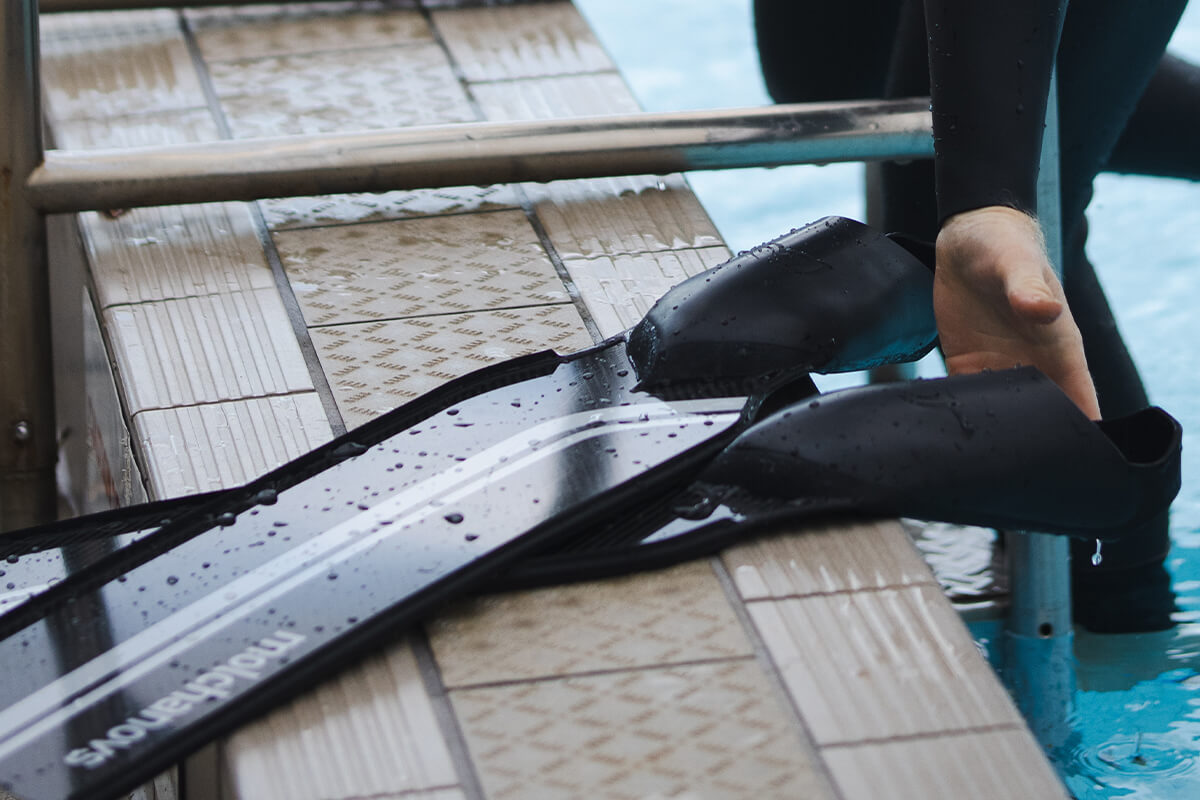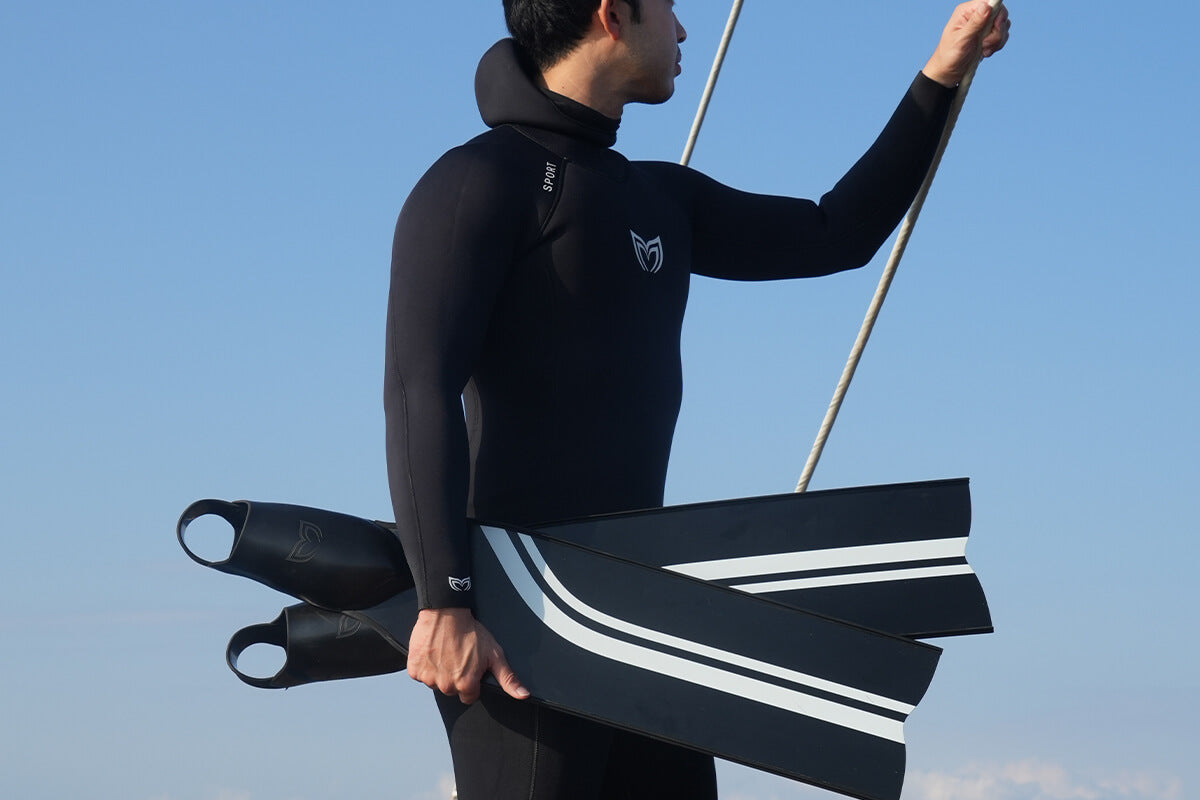Shop Freediving Fins by Type
Freediving Bifins
From full-length blades to more compact short fins, bifins offer control, versatility, and comfort for all training environments and skill levels.
Freediving Monofins
Powerful and efficient, monofins are designed for maximum glide and performance in both dynamic deep dives.
Shop Freediving Fins by Range
Carbon Freediving Fins
Ultra-responsive and built for performance. Ideal for experienced freedivers chasing depth, speed, and efficiency.
Fiberglass Freediving Fins
Tough, flexible, and reliable. A great all-around choice for more focused training and regular use.
Silicone Freediving Fins
Soft, durable, and beginner-friendly. Designed for new freedivers learning foundational technique and experienced divers perfecting their form.
Molchanovs Freediving Fin Features
Semi- and Fully-Customizable
Your body and diving style are unique–you can customize your blade size, stiffness, and angle, along with foot pocket fit on premium fins.
Premium Materials
Premium fin materials means 100% premium carbon fiber, 100% UHC fiberglass, and 100% silicone, with nothing in-between.
Comfortable Foot Pockets
Your feet deserve the best, whether it’s fully customizable hand-built foot pockets or removable open-heel silicone foot pockets.
Full Range of Fins
Monofin or bifins? Long fins or short? Custom-made fins or ones with removeable foot pockets? Whatever you need, we’ve got it.
Fins for Every Level
Whether you’re fun diving, snorkeling, mermaiding, safetying, taking underwater footage, spearfishing, or going for records–we’re with you.
Record-Breaking Bifins and Monofins
The world’s top athletes need the best, which is why they choose Molchanovs bifins and monofins to break national and world records.
Find Your Perfect Freediving Fins
Choosing the right fins for your needs makes all the difference. Whether you need the reactivity of carbon, the durability of fiberglass, or the comfort and extreme durability of silicone, we offer a variety of options for every level and diving style.
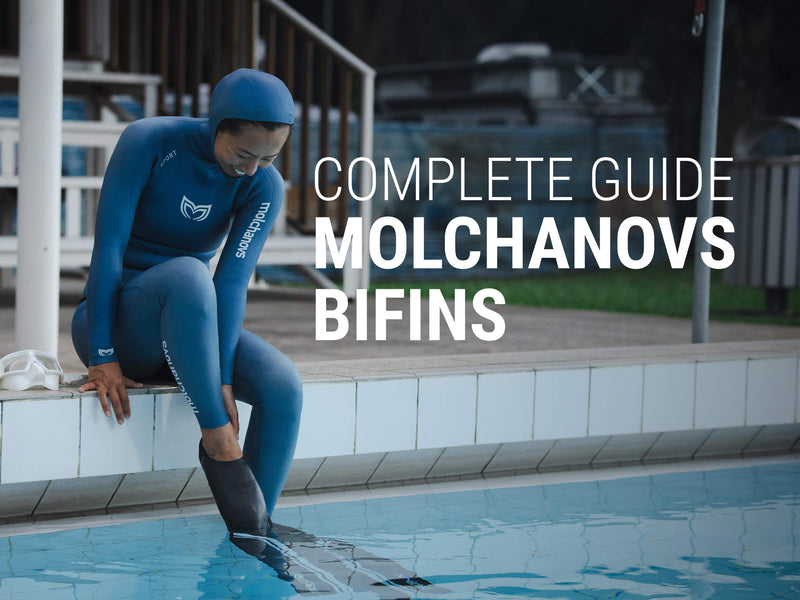
Your Complete Guide to Molchanovs Bifins
- How to Choose Between Molchanovs Freediving Bifins: Competition Fins
- How to Choose the Best Monofin for Freediving
- Molchanovs Hand-Built Foot Pockets: Standard Size or Custom Size?
- How to Choose Between Molchanovs Freediving Bifins: Training Fins for Professionals
- How to Choose Between Molchanovs Freediving Bifins: Training Fins for Beginners
- How to Choose Between Molchanovs Freediving Bifins: Fun Diving Fins
Freediving Fins FAQs
Fiberglass is generally considered to be more durable, while carbon is more lightweight and responsive. However, Molchanovs uses 100% premium UHC fiberglass blades that are in the top-performance range for both fiberglass and carbon blades overall.
There is a slight performance difference between the two, which will only be felt by freedivers who dive very deep or very far in the pool. We would suggest choosing fiberglass unless you are aiming to beat national, continental, or world records, or if you prefer a lightweight blade.
Soft-stiffness fins are suitable for smaller and lighter freedivers, and also for experienced freedivers with excellent ankle-driven technique. Softer blades are more economical in terms of energy consumption, although it mostly remains a preference among freedivers with more strength whether to choose a soft or medium stiffness.
Choose soft stiffness if:
- You’re a smaller and/or lighter freediver with less lower-body strength
- You dive in little to no current and with no extra gear (underwater camera, spearfishing equipment, thick wetsuit, etc.)
- You use a more ankle-driven technique and want efficiency
Medium-stiffness fins are suitable for larger and heavier freedivers, freedivers with more lower-body strength, or for freedivers who need more power.
Choose medium stiffness if:
- You’re larger and/or heavier and have lower-body strength or need more power
- You’re unsure whether to choose soft or medium fins
- You’re a safety diver, underwater photographer, or spearfisher
- You dive with extra gear
If your feet have a pretty standard shape and size and/or you are on a budget, then you can consider getting standard EU-sized foot pockets. But if you have very wide or very narrow feet, noticeably asymmetrical feet, or very low/high arches, then you should consider customizing your foot pockets. See Molchanovs Hand-Built Foot Pockets: Standard Size or Custom Size? for more information.
To measure your feet for custom foot pockets, you’ll need a piece of paper, a pencil, a tape measure, and a friend to help you take your measurements. See How to Measure Your Feet for Molchanovs Hand-Built Foot Pockets for the full list of directions for each measurement.
Carbon and fiberglass fins
- Avoid pressing your blades against any hard surfaces (e.g. bottom of a pool or the pool wall).
- Avoid jumping into the water while wearing your fin/s - it is recommended to put the fins on after you are already in the water.
- Rinse in fresh water after use.
- Avoid storing in direct sunlight, store in the shade instead.
- Avoid leaving fin/s in hot, dry, enclosed places (e.g. inside a car that’s in direct sunlight).
- Store horizontally on a surface or vertically in a fin rack.
- Wait until fin/s are dry before placing them in a bag or in storage.
- Use Silicone Grease on open-heel foot pockets to extend the life of your foot pockets.
Silicone fins
- Avoid placing the footpockets and back straps near sharp objects.
- Avoid placing fin/s near fabrics and materials that color bleed easily (lose their dye when wet).
- Avoid storing in direct sunlight, store in the shade instead.
- Avoid leaving fin/s in hot, dry, enclosed places (e.g. inside a car that’s in direct sunlight).
- Rinse in fresh water after use.
- Store horizontally on a surface or vertically in a fin rack.
- Wait until fin/s are dry before placing them in a bag or in storage.
For traveling with bifins, you can look to lightweight bags for short periods of travel (e.g., to a dive site from your accommodation) or pair a bag with bifin blade protection for longer periods of travel (e.g., on an airplane).
For traveling with monofins, a lightweight monofin bag will work for short periods of travel. For longer periods of travel, you can opt for a semihard monofin bag, or pair a lightweight bag with monofin blade protection.
Frequent travelers should consider a hard case, which fits a monofin, bifins, and much more equipment and provides the ultimate protection.
To see more information, check out How to Travel with Your Freediving Bifins and Monofin.
For fun diving in shallow water, we suggest the CORE Silicone Bifins for their durability, cost, and ease of transport.
But for deeper fun diving (10m+ / 33ft+), the PRO Short Bifins 3 Carbon are comfortable, maneuverable, and also easy to travel with.
For the best balance between value for money, comfort, and quality materials, we suggest the SPORT Bifins 3 Fiberglass - they come with removeable foot pockets, making it easier to travel with and change blades( if you decide to get SPORT Carbon blades in the future).
For a more comprehensive look and to see fun diving bifin ratings by category, check out How to Choose Between Molchanovs Freediving Bifins: Fun Diving Fins.
If you are just starting out on your freediving journey, the CORE Silicone Bifins are ideal for training foundational bifin technique. More experienced freedivers can also use them for perfecting their technique.
The SPORT Bifins 3 Fiberglass and Carbon are ideal for sub-max and maximum performances in training for beginner freedivers.
To see the full list of options for training bifins for beginners, see How to Choose Between Molchanovs Freediving Bifins: Training Fins for Beginners.
For freediving athletes and professionals, the PRO Bifins 3 Fiberglass and Carbon are the lightweight option while the PRO Hyper Bifins Fiberglass and Carbon are heavier but give you a more spring-like effect with every kick.
For a deeper dive into the differences between the two for training, read through How to Choose Between Molchanovs Freediving Bifins: Training Fins for Professionals.
The Molchanovs PRO Line features equipment specifically designed for freedivers seeking performance and amateur/professional freediving athletes. Similar to training bifins for professionals, you have two choices:the lightweight PRO Bifins 3 Fiberglass / Carbon or the heftier-yet-springier PRO Hyper Bifins Fiberglass / Carbon. See a more detailed breakdown of both bifins in How to Choose Between Molchanovs Freediving Bifins: Competition Fins.
For an entry-level monofin that you can use to train monofin technique efficiently, look to the CORE Silicone Monofin for its large silicone blade surface area, semi-rigid foot pocket connection, and comfort for long periods of wear.
When you’re ready for a performance monofin, you can choose between the PRO Monofin 4 Fiberglass or Carbon version. Both are highly customizable, come with the comfortable Molchanovs Hand-Built Foot Pockets, and have had multiple records made in them. As for fiberglass or carbont–this is a purely preference of whether you prefer a more durable blade (fiberglass) or a lightweight blade (carbon).
Understand more about choosing a freediving monofin in How to Choose the Best Monofin for Freediving.
